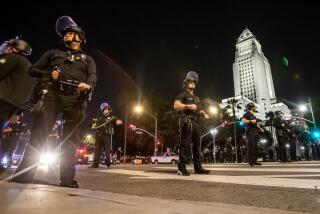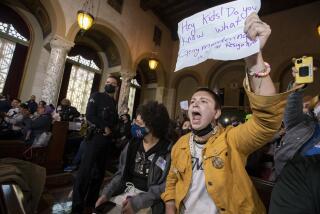When the protests came to my street

- Share via
For the last week, protesters from Black Lives Matter and similarly aligned groups have been gathering daily outside Getty House, the Hancock Park estate where Mayor Eric Garcetti lives with his family. Their mission is to send a message that the mayor is not worthy of a Cabinet appointment by President-elect Joe Biden.
Protests at the mayor’s mansion are nothing new, nor are demonstrations at the homes of elected officials. It comes with the job of being a high-profile public official. U.S. senators, governors, mayors and city council members around the country have had their homes picketed.
For the record:
6:35 a.m. Dec. 3, 20206:32 a.m. This story has been updated to change “health officers” to “health officials.”
But during this seemingly endless year of plague, the tactic has become increasingly popular and applied more broadly by people angry about, you name it: police shootings, pandemic restrictions on businesses, mask requirements and election outcomes.
Until recently, I hadn’t given much thought about the phenomenon or its ramifications for civil discourse. When the usual debate forums — city halls, public boards and commission meetings — are shuttered, where else can people go to express their dissatisfaction to the leaders who need to hear it?
But then the protests came to my street.
On Sunday, a group of about 50 people marched onto my twisty, narrow street in Echo Park to stage a demonstration outside the home of my neighbor, Los Angeles County Public Health Director Barbara Ferrer. They carried signs, American flags and Trump banners and called for Ferrer to reopen the city. And because they were mostly mask-less and crowded the sidewalks to avoid getting ticketed by police officers standing by, the event in effect trapped neighbors in our homes.
Ironically, Ferrer has consistently defended the rights of protesters, including the ones picketing her street, as constitutionally protected and exempted demonstrations from the county’s revived safer-at-home orders that began Monday.
This event was short and largely peaceful, other than a few verbal altercations with some of my neighbors who didn’t agree with the message that COVID-19 is a hoax and that President Trump was the real winner of the Nov. 3 election. But it illustrated how the personalized protests are expanding and escalating in ways that can be troubling at times. Across the country, protesters are digging up the home addresses of health officials, police officers and election officials and staging events that often seem more like harassment than legitimate debate.
Americans have a constitutional right to protest but not a right to do so in whatever way or location they choose. Los Angeles, like other cities, has laws that restrict residential protests to no closer than 100 feet from the target’s home (a pity for next-door neighbors) and the amount of noise they can make.
Los Angeles Police Chief Michel Moore said that his department tries to strike a balance between the right to protest and the right of neighbors to not feel besieged. But the threat of escalation is always there. And he would know: Moore’s house was visited by protesters in August, who pounded on the glass and marked up outside walls.
Public health officials have become a particular target in recent months because, like Ferrer, they are the face of pandemic restrictions. They have received death threats, been doxxed and had their homes picketed in ways that seem threatening, said Kat DeBurgh, executive director of the the Health Officers Assn. of California. “They are clearly designed to be intimidating, to say, ‘We know where you live and you’re not safe here,’” she said.
At their worst, some protests can threaten the civility on which democracy depends. Gabriel Sterling, a Georgia election official, has condemned Trump and other leaders for failing to stop “multiple attempted hacks of my emails, police protection around my home, the threats” and other menacing actions aimed at election workers simply doing their jobs.
In Los Angeles, the stress has taken a toll. Since the start of the pandemic, 12 local health officials and three state health officials in California alone have resigned. DeBurgh said she’s worried this will scare away doctors from these modestly paid government positions in the future.
There are those who say that protests outside private residences are never acceptable, that homes should be places of refuge and that political or policy fights should be reserved for official places of business. I don’t agree. There are times when it is the only — or most effective — way for the people to register their discontent. In fact, at the moment, for many people home is the official place of business. There’s not much point in holding a demonstration outside an empty office building.
Furthermore, the pandemic has in effect shut down most in-person opportunities for public debate, and elected officials haven’t done much to offer alternatives as they moved their meetings online. The people shouting in front of the mayor’s house this week? Not long ago, they could vent in person at Los Angeles Police Commission meetings.
One obvious solution is for elected officials to create more outlets for people to be heard by those making the rules so they aren’t compelled to march over to their homes and deliver the message in person. Otherwise, there are likely to be a lot more neighbors like me who wake up one day to find the protest has come to their street.
More to Read
A cure for the common opinion
Get thought-provoking perspectives with our weekly newsletter.
You may occasionally receive promotional content from the Los Angeles Times.










